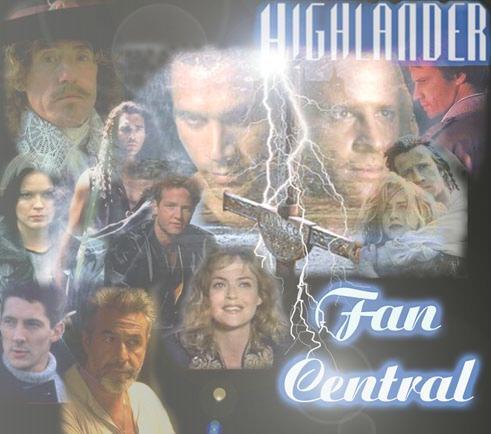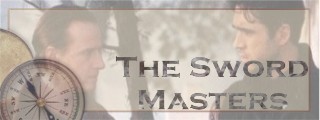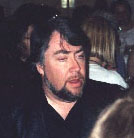|
|
|
|
|
|
So do you want to be a Swords Master when you grow up? Here is some of what awaits you in the Choreographer's chair!
F.Braun is coming out with a video series of his own that will teach you the everything from the basics to the more advanced work. He is planning to shoot his first video in August on Rapier, Broadsword and Quarterstaff. He has Eight videos planned in all. Look for his web page to be up soon. Braun is also working on a comprehensive book on swords and sword work. This book will be a compilation of all the knowledge and histories he has accumulated in over 25 years of swords work. |
Talking to F. Braun McAsh By Lyria Wollich LW: It must have been very difficult, with the short time that you had to film and choreograph the fights, especially in regards to actors untrained in swords, to pull all of that together. How did you accomplish this baring a minor miracle? FBM: Well the thing is when I'm shooting one show, I'm prepping the next one. So by the time the guest actor for the next episode arrives, I have to have his weapon not only chosen, it already has to be built and there on the set as soon as possible. I, by and large, have to have the fights choreographed by the time the actor comes in, because once he comes - and remember they are not coming in necessarily of the first day of shooting, he may not be available, they might of decided to cheap out and only bring him in the day or so before he has to work, which may or may not be the day before he has a fight scene. So all the work has to be done before the actor sets foot on the sound stage and that's where I have to basically phone him at home and say "Hi, I'm Braun. Are you right handed? left handed? Have you had any training and in what? Do you have any physical disabilities? What can you do? What can't you do?" and so on and so forth. You have to do that for every episode, for 22 episodes a year and you also have to think, "Ok, if I'm going to put a stunt in am I going to need a stunt double". You know, I tried to figure it out one time, how much rehearsal time an actor got to perform a fight for the show, because we would have to amortize our rehearsal time over a period of several days. It turned out that, basically regardless of how many days an actor had to rehearse, the average amount of time was "four hours" for a single fight scene. Now, we've had episodes with four and one even with five different fights in a single episode and we shot a single episode once every seven working days. I've had several episodes where we had fight scenes the first day of shooting. Two come to mind immediately. Yeah, sometimes it got a little bit nuts. In the four years that I did the Highlander television series, I only stunt doubled characters in small areas of the fights. Only one person that I replaced entirely for a fight scene, when that actor had had time to rehearse, he just didn't do at all. I had to replace two actors once, because they brought them in the day we were supposed to do a fight and of course that's physically impossible. LW: Even for someone who has had some fighting experience before? Even so. Especially because it was in a flashback, it was on a sand dune, and on and on, so the French stunt director Philippe Geaugan and myself did the fight for them and fortunately, the costumes were able to hide this and also this was a long shot because Duncan was supposed to be watching it, so we were able to get away with it. But even so, Philippe and I required 2 days rehearsal to do this, so the idea of the actors arriving in the morning to shoot it in the afternoon was just totally impossible. It wasn't that the actors were unskilled or may not have been able to do the fight it was the fact that it would been impossible for me an Philippe to do the fight in that short of a period. Generally speaking, ninety nine percent of the actors on Highlander including the guest stars and what not all did the fights themselves. And the reason behind that is basically it affords us greater latitude to film the fight. We don't have to worry about hiding faces. It just makes it a whole lot easier because you have more usable film, and you don't have to restrict camera angles, you can go in close and yes, it's them Besides, most stunt men have no idea how to handle a sword, so if I'm going to end up teaching someone from scratch it might as well be the actor. LW: What was your most difficult fight to choreograph? FBM: Oh Gee, The fights in Duende were very difficult to choreograph but they weren't very difficult to rehearse because I was working with two very physical actors. That wouldn't really count because even though they were difficult, they were fun to choreograph. But when you talk about degree of difficulty I would say it wasn't the individual fights, It would be the battle scenes. Generally speaking, when we have battle scenes, I don't get to pre-rehearse much. There was only one battle scene we did where I got to pre-rehearse with anybody and that was simply because the stunt men had to fight one of the principals. Generally, in battle scenes, although I have it all pre-choreographed, because I have to be very specific with the director as to camera shots, what is the camera going to see, when does the camera stop seeing areas and so on so forth. Battle scenes are basically choreographed by me mainly showing up with a handful of fight scripts and on the day that we're shooting. I'm presented with fifty or sixty stuntmen and a pile of weapons and say "ok, there's the ground, there's the guys you're going to fight, there's the stuff and we're going to shoot the battle scene in three hours." So that's how we worked on series as far as battles. And quite often movies do that too. I know Bill Hobbes has been presented with that kind of situation on more than one occasion. So yeah, it's pretty weird. Obviously, you have all the stuff pre-choreographed, but there's a lot of adjustment that has to be done there on the spot. You know, you are working with uneven terrain, you may or may not have been able to see the location survey. When I was in France, since we were doing no studio work, three quarters of the fight scenes that I did in France, I never saw the location except for the day we walked in and did the fight. I simply wasn't available to do so. I would be fifty miles on one side of Paris filming something, while the location people were scouting fifty miles on the other side of Paris, so I was relying on the location people to give me very precise measurements of the site, and the condition of the ground, and things like this. Then, of course, very often in these battle scenes you had the principal actors having to run through either fighting or not fighting and that, of course, presents a big hazard because working with any kind of battle or brawl situation, a lot of people are swinging weapons. The weapons are no longer just dangerous to the people in front of them, they become dangerous to the people beside and behind them. Half of the problems in choreographing a battle are meshing groups of people that have to fight past each other, around each other. When a person winds up for a blow where is the sword going behind him? The movement pattern has to be extremely precise, and the timing has to be very precise too. Group b cannot go before group c and group c cannot start their fight until they let group d pass through them. Group e in the background cannot go past until group d gets half way through them, and so either you block camera shots - you know, you block the camera seeing what it's supposed to see; or you end up with two groups that are too close together at the wrong time. LW: Did you have a particular type of cueing sequence that facilitated these intricate movements between different groups, like a set of hand signals or something of that nature? FBM: Well, once I'm choreographing it, once people already know their physical actions, then I put them together one group at a time. And I cue them in like in anything else like, "Ok, group a, start. Group b, go. Group c ready? Group c go. Group a get out of there! Group e, go. Group d prepare!" and when you're filming you're basically doing the same thing. You use hand signals. You yell. Most of the noise you hear in sword fights and battle scenes are not being recorded while we actually film, It's being put in in post production fully. If necessary, if hand signals don't cut it, yeah, you yell "Group a now! Group b, not yet! Group d prepare!" Stunt men who do this for a living, rehearse the fight, and really start to see where they're supposed to come in. When they're in shot, out of shot, for the most part they are aware of the camera. They're used to watching all around them, unlike a lot of actors, because actors don't' have the experience or training, and are used to looking in all directions to protect themselves from things. It might not necessarily be their part of the fight, but they kind of know pinot. Generally speaking they're pretty safe to work with as long as they are being properly directed. So yeah, I would have to say, it's not really the individual combat, but in my mind the battle scenes that we're forced to do on short notice, with very little personal time and filming time. |
NEW! Sword Master Biographies The information on this page was taken from an interview given by
In the weeks to come look for more exciting Sword information from Anthony De Longis! and Mary Galien
|
|




